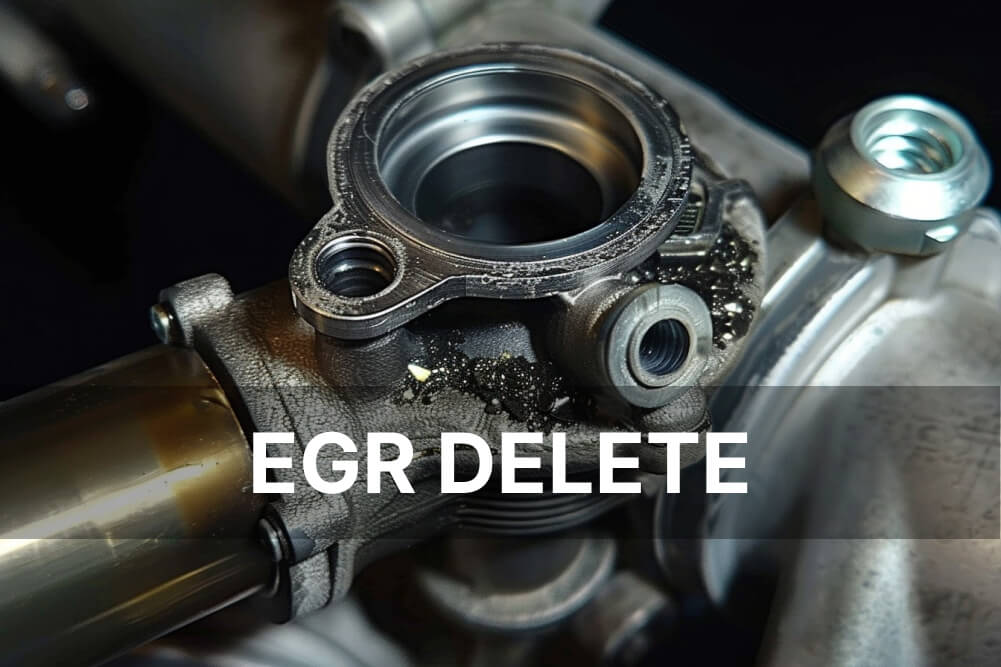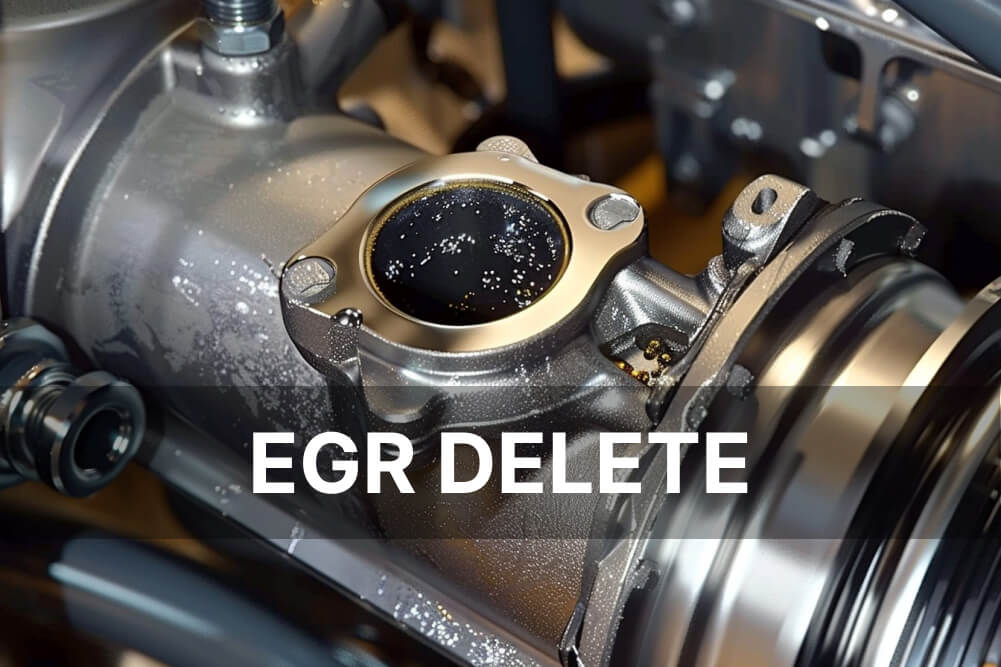EGR Delete
EGR Removal Tuning: Optimize Engine Performance
Enhance your vehicle's performance with our professional EGR (Exhaust Gas Recirculation) removal tuning service. As experienced automotive engineers specializing in engine calibration, we offer precise ECU modifications to maximize engine efficiency and power output.
Benefits of EGR Removal:
- Improved throttle response and acceleration
- Increased horsepower and torque
- Enhanced fuel efficiency
- Reduced carbon buildup in intake manifold
- Extended engine lifespan

Technical Process:
Our EGR removal tuning involves sophisticated ECU reprogramming to eliminate the EGR function while maintaining optimal engine performance. We adjust various parameters, including:
- Fuel injection timing and duration
- Ignition timing maps
- Air-fuel ratio targets
- Boost pressure control (for turbocharged engines)
- Removal of EGR-related diagnostic trouble codes (DTCs)
Key Maps and Parameters Modified for EGR Delete:
-
EGR Duty Cycle Maps
- Function: Control EGR valve opening and closing
- Modification: Set duty cycle values to zero across all conditions
-
EGR Flow Maps
- Function: Regulate recirculated exhaust gas amount
- Modification: Adjust flow values to zero
-
EGR Temperature Maps
- Function: Monitor recirculated exhaust gas temperature
- Modification: Set temperature thresholds to indicate no recirculation
-
EGR Position Maps
- Function: Track EGR valve position
- Modification: Set to constant closed position
-
Diagnostic Trouble Codes (DTC) Maps
- Function: Store EGR-related fault codes
- Modification: Disable or remove EGR-related fault codes
-
EGR Adaptation Maps
- Function: Handle EGR system adaptation values
- Modification: Reset or disable adaptation values
Important Notes:
- For most EGR deletes, setting duty maps to zero and deleting corresponding active DTC codes is sufficient
- An alternative solution is disconnecting the high-pressure EGR actuator and removing all corresponding PCodes
- It's always advisable to disconnect the actuator and ensure the EGR valve is completely closed

Customized Tuning Approach:
Each EGR removal file is tailored to your specific vehicle make, model, and engine configuration. Our engineers analyze your ECU data to create a bespoke tuning solution that maximizes performance while ensuring reliability.
Streamlined Service:
- Register and purchase credits on our secure platform
- Upload your ECU read file through our file service
- Our expert engineers process and modify your file (typically within 30 minutes)
- Download your custom tuning file and flash it to your ECU
- Test drive and enjoy improved performance
Ongoing Support:
We provide comprehensive technical support throughout the tuning process. If you encounter any issues or require adjustments, our team is committed to ensuring your complete satisfaction.
Experience the difference of professional EGR removal tuning. Unlock your engine's true potential with ziptuning.com – where precision engineering meets unparalleled performance.
Need EGR-delete tuning file?
EGR Delete FAQs
What are the primary functions of an EGR system in a modern engine?
The primary functions of an EGR system are to reduce NOx emissions by lowering combustion temperatures and improve fuel efficiency under certain conditions.
How does EGR removal affect NOx emissions in diesel engines?
EGR removal typically increases NOx emissions in diesel engines due to higher combustion temperatures. This can lead to significant increases in harmful emissions.
Can you explain the process of modifying EGR duty cycle maps during an EGR delete?
Modifying EGR duty cycle maps involves setting the duty cycle values to zero across all operating conditions, ensuring the EGR valve remains closed at all times.
What are the potential risks of increased combustion temperatures after EGR removal?
Increased combustion temperatures after EGR removal can lead to increased thermal stress on engine components, potentially accelerating wear on pistons, valves, and cylinder heads.
How does EGR deletion impact fuel economy in different driving conditions?
EGR deletion often improves fuel economy under high-load conditions but may decrease efficiency during low-load operation. Overall impact varies depending on driving habits and conditions.
What are the legal implications of EGR removal in various jurisdictions?
EGR removal is often illegal for on-road vehicles in many jurisdictions due to emissions regulations. It may be permitted for off-road or racing applications in some areas.
How does removing the EGR system affect engine longevity?
EGR removal can potentially extend engine life by reducing carbon buildup and eliminating EGR-related failures. However, increased combustion temperatures may accelerate wear on some components.
Can you describe the process of disabling EGR-related diagnostic trouble codes?
Disabling EGR-related DTCs involves modifying the ECU software to ignore or suppress fault codes related to the EGR system, preventing check engine lights and limp mode activation.
What are the differences in EGR delete benefits between gasoline and diesel engines?
In gasoline engines, EGR deletion typically offers less significant benefits compared to diesel engines, as gasoline engines generally have lower EGR rates and less carbon buildup issues.
How does EGR removal impact turbocharger performance and lifespan?
EGR removal can increase exhaust gas temperatures and flow, potentially improving turbocharger response but also increasing thermal stress on the turbo components.
What modifications to the ECU are necessary to optimize performance after EGR deletion?
ECU optimization after EGR deletion may include adjusting fuel maps, ignition timing, and boost pressure control to account for changes in intake air temperature and composition.
How does EGR removal affect exhaust gas temperatures, especially in diesel engines?
EGR removal typically increases exhaust gas temperatures, especially in diesel engines. This can lead to increased thermal stress on exhaust components and the turbocharger.
What are the potential impacts on engine warranty when performing an EGR delete?
EGR removal almost always voids the engine warranty, as it involves modifying a critical emissions control system.
How does EGR deletion influence cold start performance and emissions?
EGR deletion can negatively impact cold start performance and emissions, as EGR helps with faster catalyst light-off and reduces cold-start NOx emissions.
Can you explain the relationship between EGR removal and potential engine knocking?
EGR removal can increase the likelihood of engine knocking, especially in gasoline engines, due to higher combustion temperatures and changes in charge composition.
What are the best practices for ensuring proper engine cooling after EGR removal?
Best practices include ensuring proper coolant levels, considering upgraded cooling systems, and potentially adjusting ECU parameters to manage higher combustion temperatures.
How does EGR deletion impact the effectiveness of other emission control systems?
EGR deletion can increase the load on other emission control systems, particularly the catalytic converter and diesel particulate filter (in diesel engines), potentially reducing their effectiveness and lifespan.
What are the differences in EGR delete procedures for high-pressure and low-pressure EGR systems?
High-pressure EGR systems typically require more extensive ECU modifications, while low-pressure systems may be simpler to delete but can have a greater impact on turbocharger operation.
How does EGR removal affect the engine’s air-fuel ratio across different load conditions?
EGR removal generally leads to a leaner air-fuel ratio across all load conditions, which may require fuel map adjustments to maintain optimal performance and prevent lean-running conditions.
What are the potential long-term effects of EGR removal on engine components such as valves and pistons?
Long-term effects can include increased valve and piston wear due to higher temperatures, potential increases in oil consumption, and accelerated degradation of exhaust components due to higher exhaust temperatures.
What are the most common fault codes related to EGR problems?
EGR System General Codes:
P0400: Exhaust Gas Recirculation Flow Malfunction
P0401: Exhaust Gas Recirculation Flow Insufficient Detected
P0402: Exhaust Gas Recirculation Flow Excessive Detected
P0403: Exhaust Gas Recirculation Circuit Malfunction
P0404: Exhaust Gas Recirculation Circuit Range/Performance
P0405: Exhaust Gas Recirculation Sensor A Circuit Low
P0406: Exhaust Gas Recirculation Sensor A Circuit High
P0407: Exhaust Gas Recirculation Sensor B Circuit Low
P0408: Exhaust Gas Recirculation Sensor B Circuit High
P0409: Exhaust Gas Recirculation Sensor A Circuit
EGR Valve Position Sensor Codes:
P1404: EGR Valve Position Sensor Circuit Low Input
P1405: EGR Valve Position Sensor Circuit High Input
P1406: EGR Valve Position Sensor Circuit Intermittent
P1408: EGR Flow Out of Self-Test Range
EGR Temperature Sensor Codes:
P0486: Exhaust Gas Recirculation Sensor B Circuit
P0487: Exhaust Gas Recirculation Throttle Control Circuit A Open
P0488: Exhaust Gas Recirculation Throttle Control Circuit A Range/Performance
P1489: EGR Vacuum Solenoid Circuit
P1490: EGR Vacuum Solenoid Circuit Malfunction
EGR Valve Control Codes:
P0489: Exhaust Gas Recirculation Control Circuit Low
P0490: Exhaust Gas Recirculation Control Circuit High
P0491: Secondary Air Injection System Insufficient Flow
P1409: EGR Vacuum System Leak Detected
EGR Pressure Feedback Codes:
P1406: EGR Pressure Feedback Sensor Circuit High
P1407: EGR Pressure Feedback Sensor Circuit Low
EGR System Performance Codes:
P0401: EGR Flow Insufficient Detected
P0402: EGR Flow Excessive Detected
P1404: EGR System Range/Performance Problem
P1406: EGR Valve Pintle Position Circuit
EGR Cooler Codes:
P2457: EGR Cooling System Performance
P2458: EGR Cooler Bypass Valve Control Circuit
P2459: EGR Cooler Bypass Valve Control Circuit Range/Performance
Additional Related Codes:
P0097: Intake Air Temperature Sensor 2 Circuit Low
P0098: Intake Air Temperature Sensor 2 Circuit High
P0099: Intake Air Temperature Sensor 2 Circuit Intermittent/Erratic
P0100: Mass or Volume Air Flow Circuit Malfunction
P0101: Mass or Volume Air Flow Circuit Range/Performance Problem
P0102: Mass or Volume Air Flow Circuit Low Input
P0103: Mass or Volume Air Flow Circuit High Input
P0104: Mass or Volume Air Flow Circuit Intermittent
SPN 2791: Exhaust Gas Recirculation (EGR) Valve Position
SPN 2792: EGR Valve Control Circuit
SPN 411: EGR Differential Pressure
SPN 412: EGR Temperature
SPN 2659: EGR Mass Flow Rate
SPN 2791: EGR Valve 1 Control
SPN 3936: EGR Cooler Bypass Status
SPN 3242: EGR Cooler Temperature
SPN 3251: EGR Cooler Efficiency
SPN 7138: EGR Position Sensor
SPN 3464: EGR Mass Flow Rate Sensor
SPN 3226: EGR Cooler Bypass Valve Position
SPN 2791: Exhaust Gas Recirculation (EGR) Valve Position
SPN 2792: EGR Valve Control Circuit
SPN 411: EGR Differential Pressure
SPN 412: EGR Temperature
SPN 2659: EGR Mass Flow Rate
SPN 2791: EGR Valve 1 Control
SPN 3936: EGR Cooler Bypass Status
SPN 3242: EGR Cooler Temperature
SPN 3251: EGR Cooler Efficiency
SPN 7138: EGR Position Sensor
SPN 3464: EGR Mass Flow Rate Sensor
SPN 3226: EGR Cooler Bypass Valve Position

